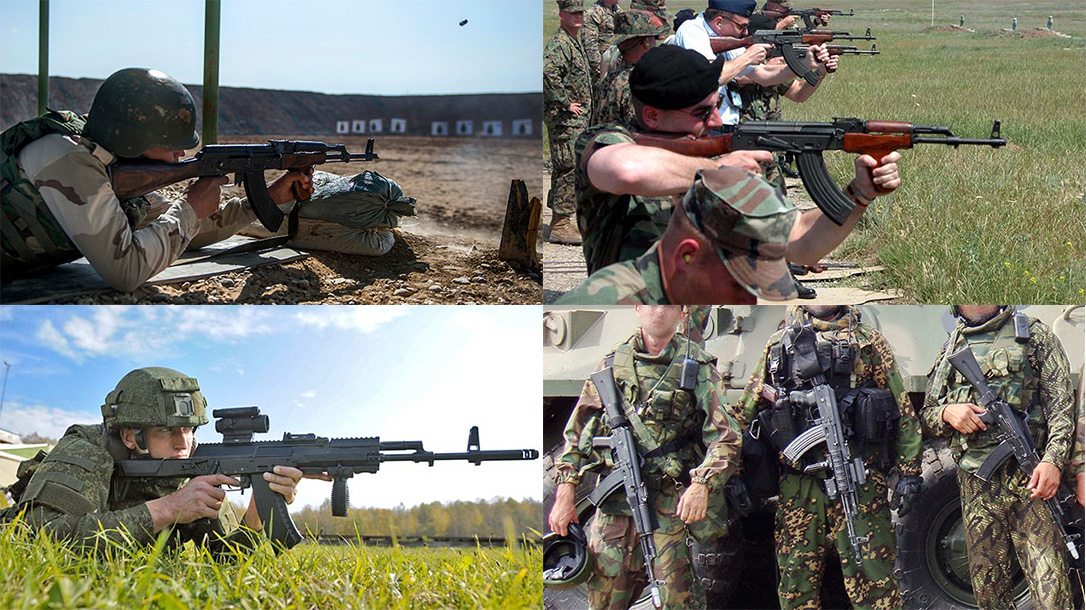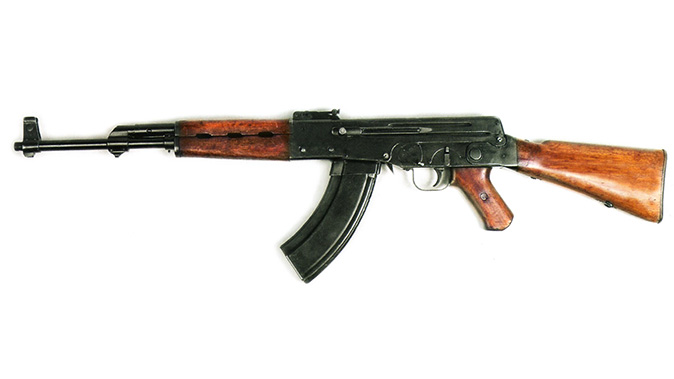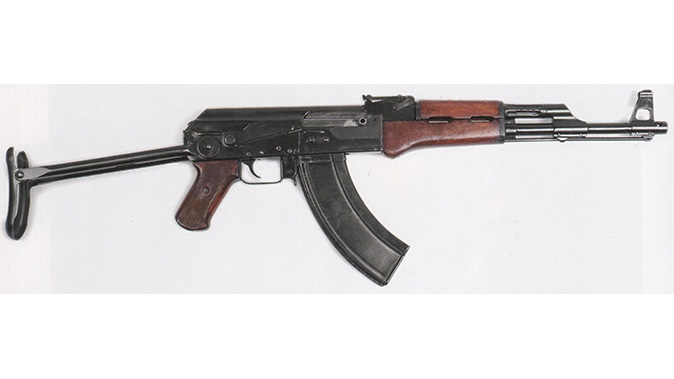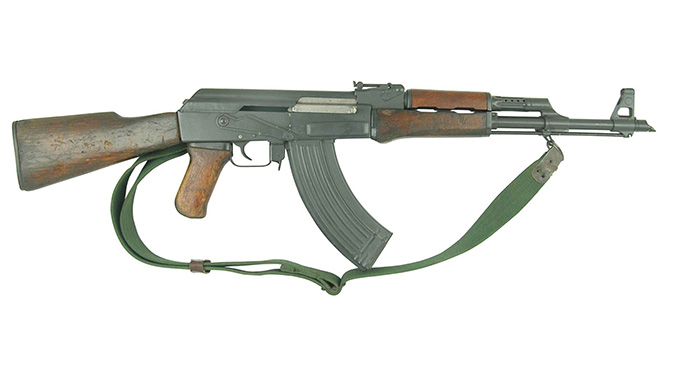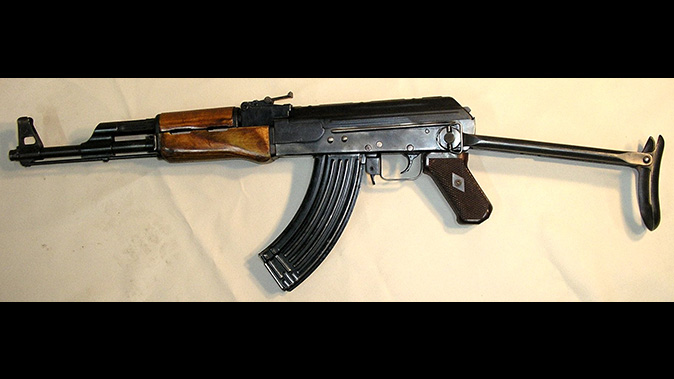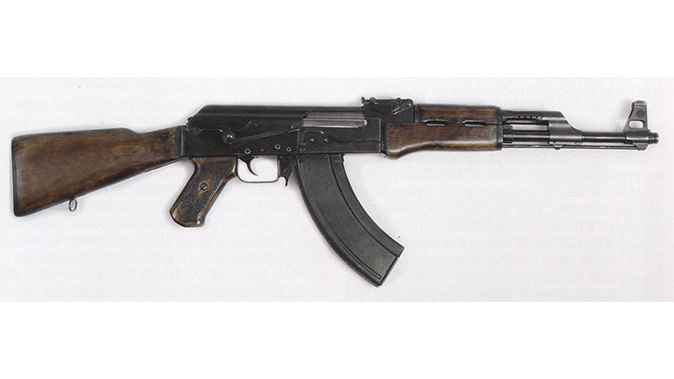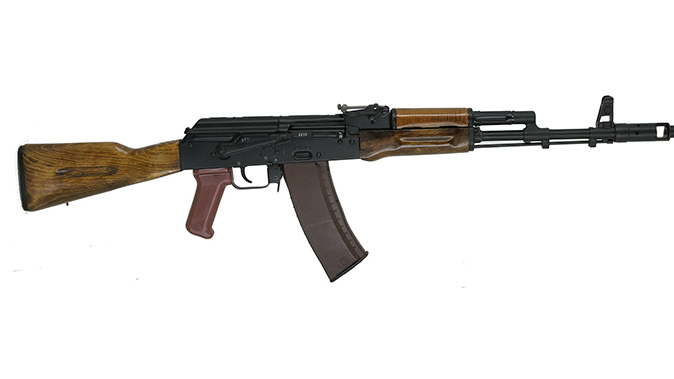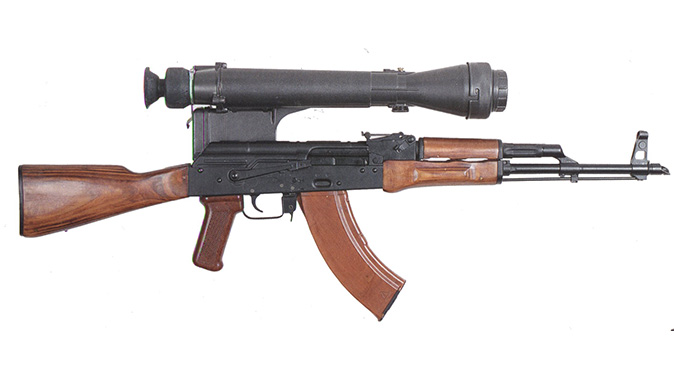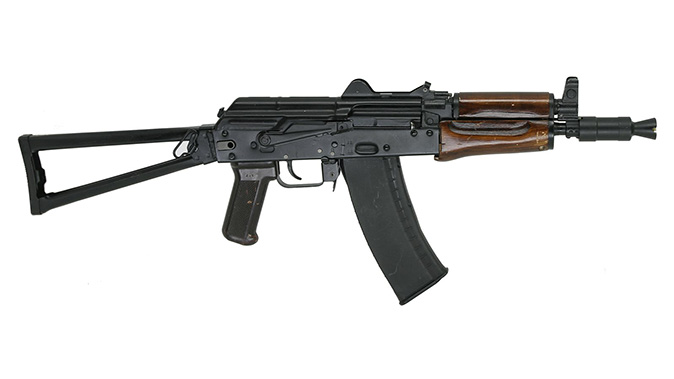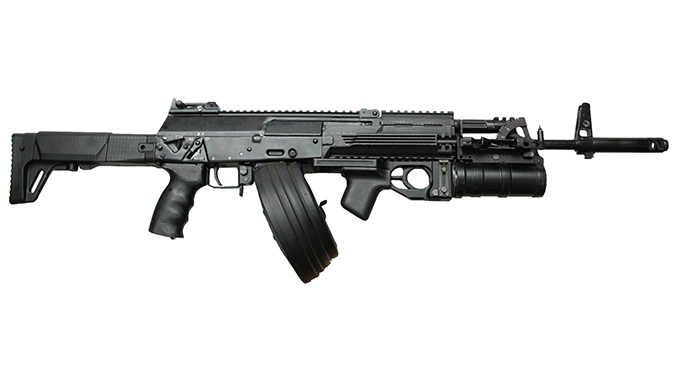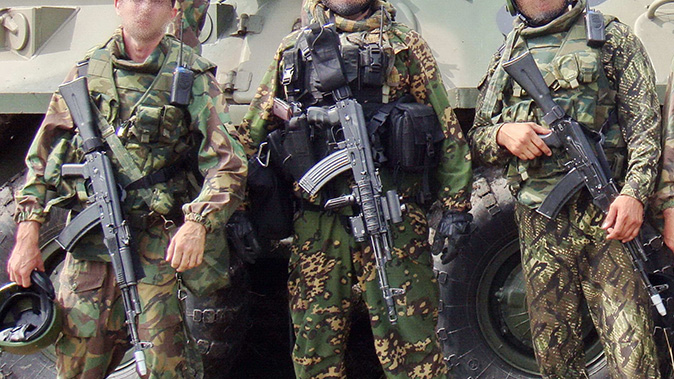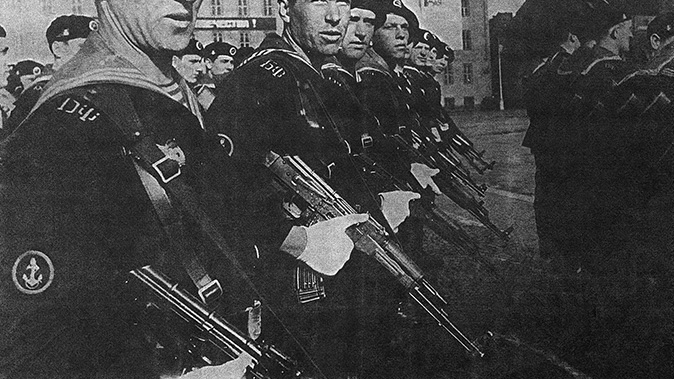The story of the Kalashnikov assault rifle began in 1942, during the hardest part of World War II, when the Soviet Union desperately fought against the invading Nazis. Two events took place during that year. First, a young, wounded tanker, Sergeant Mikhail Kalashnikov, began to design his first small arm, a submachine gun while on medical leave. Second, during the winter of 1942, the Red Army captured the first specimen of the newest German weapon, the Mkb 42(H) machine carbine and its 7.92mm Kurz ammunition.
These trophies were carefully examined and proved to Soviet experts that it was entirely possible to improve both the range and accuracy of shoulder-fired automatic weapons while retaining the relative weight and size of the typical PPSh-41 submachine gun. The Red Army immediately requested the development of an intermediate cartridge in 7.62mm caliber, and designers B.V. Semin and N.M. Elizarov developed such ammunition by the end of 1943. It had a bottlenecked case 41mm long and fired a pointed, jacketed bullet weighting 8 grams (the case was shortened to 39mm in 1947 with the introduction of the steel-core, boat-tailed bullet).
Auto Development
With the new cartridge, Soviet designers began to work on automatic rifles. First was Alexey Sudayev, who developed his first assault rifle, known as the AS-44, by early 1944. This was a gas-operated, locked-breech design with a tilting bolt that was submitted for trials by mid-1944. The Red Army then ordered a small batch of AS-44 rifles with an appropriate amount of ammunition for extended field trials. It received them in 1945. Unfortunately, Sudayev’s severe illness and untimely death in mid-1946 (he was just 33 when he died) terminated the development of the AS-44.
Advertisement — Continue Reading Below
By 1945, it was clear that an automatic rifle was necessary for the Red Army to replace its powerful but obsolete bolt-action rifles and underpowered submachine guns, and full-scale competitive trials were ordered. The first official trials for a new “avtomat” (automatic rifle) were conducted in 1945, followed by several more rounds in 1946 and 1947. Several designers, including Vasily Degtyarov, Fedor Tokarev, A. Bulkin, Dementiev, Georgy Shpagin, Mikhail Kalashnikov and G.A. Korobov, submitted their creations. None of the designs were found entirely satisfactory during testing, however, and further development and trials were ordered.
Rifle Refinement
After recovering from his wounds, Mikhail Kalashnikov was assigned to the Red Army’s small-arms proving ground in Schurovo, where he thoroughly re-designed his first avtomat, which was initially known as the AK-46. With the help of experienced small-arms designer Sasha Zaytsev, he changed the receiver design, replaced the separate short-stroke gas piston with the now-familiar long-stroke piston integral with the bolt carrier, and replaced the separate safety switch and fire selector with a single lever, inspired by the Browning-designed Remington Model 8 rifle.
Advertisement — Continue Reading Below
It must be noted that some “new” features were borrowed from competing designs, like Bulkin’s TKB-415, or suggested by proving ground personnel. This was a common practice in the Soviet Union, where all intellectual property belonged to “the people,” or, actually, to the state, rather than to an individual or organization, and was free to use by everyone as long as it was put to the benefit of the state.
During the trials, none of contestants performed entirely up to the military’s requirements, with the Bulkin design being the most accurate and Kalashnikov’s being the most rugged and reliable. After lengthy discussions, the trial commission decided that a reliable weapon with “passable” accuracy, available right now, was better than a reliable and accurate rifle available next year, or in the next decade, and decided to recommend the AK-47 for adoption, with suggestions for further improvements.
Army Adoption
The Soviet Army ordered significant numbers of AK rifles for final troop trials, which were conducted in extreme secrecy. During the following two years, the Avtomat Kalashnikova incorporated more than 100 various modifications and changes. Finally, in 1949, the improved rifle was officially adopted as the “7.62mm Avtomat Kalashnikova,” or simply “AK” (with a fixed buttstock) and “AKS” (with an under-folding buttstock). It should be noted the “AK-47” designation was officially used only for the prototype rifles submitted for trials in 1947 and never appeared in any Soviet official documents regarding Army-issued rifles.
Advertisement — Continue Reading Below
The year 1947 marked a start of a whole Kalashnikov era. Made in huge numbers (most sources state that more than 70 million AK-pattern rifles have been made in the world to date), this became one of the most famous and widespread small arms in modern history. Most of its descendants, made in the USSR and Russia during the following 50 years as well as in many other countries, with very few changes. The platform was improved with the introduction of the stamped-receiver AKM rifles in 1959, and the caliber was reduced from 7.62x39mm to 5.45x39mm in 1974. But internally, the AK-74M, manufactured since the early 1990s, is mostly still the same AK of 1949 vintage.
Stalwart Design
Some experts dare to say that the domination of Kalashnikov and his rifle was not good for the Russian arms industry. Indeed, there were many very interesting designs submitted for trials against the Kalashnikov between 1957 and 1959 and again between 1971 and 1974, but each time the Army preferred the already familiar and proven AK derivatives over the more effective or less expensive but entirely new designs. The AK was designed with the high probability of a Third World War in mind. It was extremely simple to learn and maintain, and can survive tremendous amounts of abuse, which can be expected in a large-scale war fought by large masses of poorly educated and trained conscripts. Fortunately, this never happened, but these properties of the AK made it extremely popular among revolutionary movements, freedom-fighting groups and all other non-professional warriors who needed crude, simple yet effective weapons.
Evolving AK Designs
The first major step in the evolution of the AK was made after the trials of 1957 and 1959, which included the modified AK, the Simonov assault rifle (loosely based on his famous SKS carbine), the Korobov TKB-517 and several other weapons. This resulted in the adoption of the slightly modified Kalashnikov AKM. It is almost unknown to the general public that the AKM prototype was outperformed by the Korobov TKB-517, which also was lighter, about 30-percent less expensive and more stable in full-auto fire thanks to its Kiraly-type delayed blowback system. The exact reasons for the rejection of the Korobov system were not published, but it is believed that the Soviet Army decided that the “best is the enemy of the good,” and stuck to the familiar weapon, which was made lighter and noticeably less expensive to make thanks to the stamped-steel receiver that replaced earlier machined units.
Advertisement — Continue Reading Below
AK-74
The switch to a smaller caliber, which occurred in the Soviet Army in 1974, did not help a lot. This changeover was caused by American M16 rifles captured in Vietnam during the early 1960s and supplied by the North Vietnamese government to the USSR in exchange for military support. The small-caliber M16 greatly impressed the Soviet experts with its accuracy and lightweight ammunition, and in the mid-1960s work was started on creating Soviet small-caliber cartridges.
Of course, the smaller and lighter 5.45x39mm cartridge generates much less recoil and has a flatter trajectory, so it is easier to control the rifle in full-auto fire, or to fire single shots accurately in rapid fire. There is also a huge logistical gain, because even a typical one-man combat load of eight magazines (240 cartridges) resulted in weight savings of about 1.4 kilograms (roughly 3 pounds). Given the size of the Soviet Army, this provides an extremely impressive gain in weight savings alone, as well as in the amount of raw materials needed to produce new ammo.
After the trials conducted in 1970 and 1971, the Soviet Army again selected the famous and familiar AKM, rebarreled for the smaller-caliber round and designated as the A3, over the noticeably more effective SA-006 Konstantinov assault rifle developed in Kovrov. Designated in service as the AK-74, it was basically still the same old AKM of 1959, with the same properties, handling, extreme simplicity and reliability (after some teething problems with insufficient receiver strength and barrel bulging). Interestingly, Mikhail Kalashnikov himself initially resisted this changeover, feeling that existing 7.62x39mm rifles were entirely satisfactory, and he was literally forced to produce a smaller-caliber version of the AKM.
Advertisement — Continue Reading Below
Abakan Trials
During the mid-1970s, several designers developed and offered to the Soviet Army new compact assault rifles intended as personal-defense weapons for tank and helicopter crews and other non-infantry personnel. This resulted in a research program and subsequent trials codenamed “Modern.” Several designs were tested, including the short-recoil-operated TKB-0116, developed in Tula by Stechkin, as well as the gas-operated AG-043 by Simonov (the creator of the famous SKS carbine) and the AO-46 by Tkachev (this was the most unusual design, with a proprietary box magazine serving as a pistol grip), developed in Klimovsk. Not surprisingly, the military preferred the slightly modified but still familiar Kalashnikov design from Izhevsk, adopted as the AKS-74U in 1979.
Requirements
But soon it was discovered that even the newest AK-74 left a lot to be desired so, in 1979, the Soviet Army ordered a new research program, codenamed “Abakan” after a small city in Russia. This program was intended to develop a new 5.45x39mm rifle that had to be at least 150 percent as effective (in terms of target hit probability under “near real-life” circumstances) as the AK-74. Initial requirements of the Abakan program were based on the experimental results, achieved during the late 1960s and early 1970s by several prototype assault rifles, developed in Tula by Gennadij Korobov and in Klimovsk by Pavel Tkachev.
Advertisement — Continue Reading Below
These rifles introduced Soviet experts to such concepts as a dual high/low rate of fire, with the low rate intended for long bursts and a high rate for limited-length bursts of two or three rounds, as well as balanced and soft-recoil systems. The high rate of fire for three-round bursts significantly increased the accuracy and effectiveness, and this was one of the basic requirements included into the Abakan program from the start.
AN-94 To AK-74M
The Abakan trials continued until the summer of 1986, when they were suddenly stopped before recommencing in late 1986. At that point, the Soviet Army announced the Nikonov ASM as the favorite; it had achieved a 130-percent increase in effectiveness over the AK-74. The second contender was the Kalashnikov AKB with a 70-percent increase in effectiveness, and the third was the Korobov TKB-0111 with a 50-percent increase. The trials were completed in 1987, and the Nikonov ASM was recommended for adoption. But it was not until 1994, when the modified Nikonov design had been officially adopted by the Russian government as the “5.45mm Avtomat Nikonova obraztsa 1994,” or simply the “AN-94.”
Severe economic problems encountered after the fall of the Soviet Union in 1991 resulted in the failure of the AN-94 program on the grounds of high manufacturing costs. As a result, an improved AK-74M was developed for the Russian Army during the early 1990s that was more or less a standard AK-74 fitted with a side-folding polymer shoulder stock and a side-mounted rail for the installation of night or day optics.
Advertisement — Continue Reading Below
Ever-Evolving
It must be noted that while the 5.45x39mm rifles were standardized in the Soviet Army in 1974, the earlier 7.62x39mm AKM rifles were not declared obsolete and can still be encountered among some non-infantry units, such as the Air Force. Special police and Ministry of Internal Affairs (MVD) troops, especially those operating against the separatists in Chechnya, also sometimes prefer the hard-hitting 7.62x39mm rifles to the more modern 5.45x39mm weapons. This steady popularity of the 7.62x39mm ammunition, as well as export prospects, resulted in the appearance during the early 1990s of the so-called “hundred series” Kalashnikov rifles (based on the AK-74M), chambered for 7.62x39mm as well as 5.56x45mm NATO ammunition. The latest product in the long line of AK assault rifles is the AK-12, which, apparently, is still the same inside but features some modern exterior upgrades, including a better stock, controls and integral Picatinny rails all around.
Still Fighting
As of this writing, the AK-74M is still a primary infantry weapon of the Russian Army. It is also widely issued to law enforcement units across Russia. However, it is generally considered inadequate and outdated (which was proven more than 20 years ago during the Abakan trials). It is believed that a replacement for the AK-74M could be found during the ongoing “Ratnik” trials, which include three major contenders: the aforementioned AK-12 from Izhevsk, the A-91M bullpup from Tula and the balanced-action AEK-971 from Kovrov. It is yet to be seen if any of these contenders will fulfill the requirements of the Russian military.
In any case, due to huge stocks of various AK-type rifles made to date, Kalashnikov rifles will serve throughout the world for decades to come, despite the passing of its designer and namesake, Mikhail Kalashnikov, who died at the age of 94 on Dec. 23, 2013.
Advertisement — Continue Reading Below
This article was originally published in ‘AK-47 & Soviet Weapons’ 2017. To subscribe, visit outdoorgroupstore.com.
